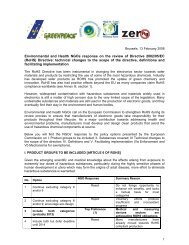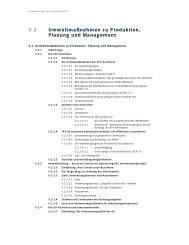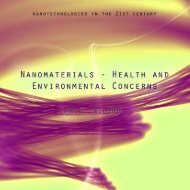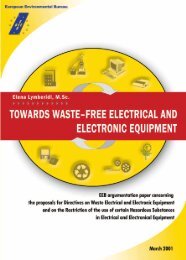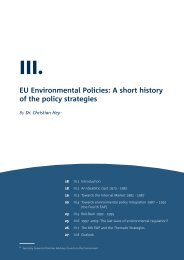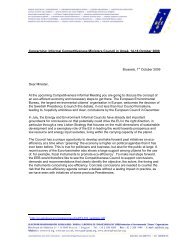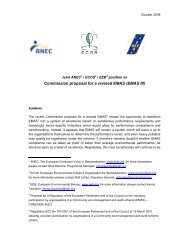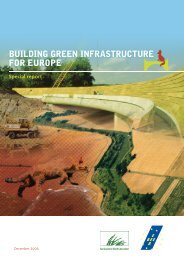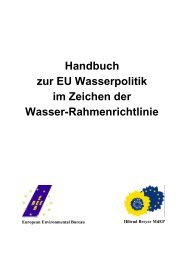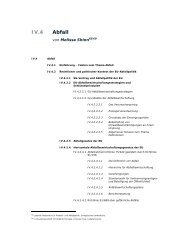Eu Mercury phase out in Measuring and Control Equipment - EEB
Eu Mercury phase out in Measuring and Control Equipment - EEB
Eu Mercury phase out in Measuring and Control Equipment - EEB
Create successful ePaper yourself
Turn your PDF publications into a flip-book with our unique Google optimized e-Paper software.
REPORT FROM THE CONFERENCE “EU MERCURY PHASE OUT IN MEASURING AND CONTROL EQUIPMENT”The results of the study: In 5 developed/OECD countries substitutes were available <strong>and</strong> readily used (“Level 2” ofsubstitution). In 5 develop<strong>in</strong>g countries substitutes were available but m<strong>in</strong>imally used (“Level 1”) In 3 develop<strong>in</strong>g countries there were no substitutes available (“Level 0”)General f<strong>in</strong>d<strong>in</strong>gs were that there was a special need to support develop<strong>in</strong>g countries (e.g. education,create a level play<strong>in</strong>g field <strong>in</strong> terms of availability <strong>and</strong> accessibility, pric<strong>in</strong>g of alternatives, etc.).In 2003 UNEP´s Program on <strong>Mercury</strong> was established. It aims to: Support actions to prevent mercury pollution Evaluate long term global policy frameworks Work with stakeholders to reduce global mercury supply <strong>and</strong> dem<strong>and</strong>Additionally, the UNEP Govern<strong>in</strong>g Council <strong>in</strong> 2005 urged the UNEP <strong>Mercury</strong> Programme to<strong>in</strong>itiate the Global <strong>Mercury</strong> Partnership work<strong>in</strong>g together on a voluntary basis with <strong>in</strong>dustry,science, professional associations, NGO´s <strong>and</strong> <strong>in</strong>dividuals, as an approach to reduce risk of mercuryto human health <strong>and</strong> the environment.Dur<strong>in</strong>g the UNEP Govern<strong>in</strong>g Council meet<strong>in</strong>g <strong>in</strong> 25 February 2009 there was a breakthroughdecision on <strong>in</strong>itiat<strong>in</strong>g a legally b<strong>in</strong>d<strong>in</strong>g <strong>in</strong>strument for mercury. This was supported by the newlyelected government of the United States <strong>and</strong> an agreement (GC Decision 25/5) on a legally b<strong>in</strong>d<strong>in</strong>g<strong>in</strong>strument for mercury by 2013 could be made. There will be the first <strong>in</strong>tergovernmentalnegotiations <strong>in</strong> June 2010 which will cont<strong>in</strong>ue <strong>in</strong> 2011 <strong>and</strong> 2012. A plenipotentiary conference ofParties will take place <strong>in</strong> 2013.The first step is to convene an open ended work<strong>in</strong>g group <strong>in</strong> October 2009 where the work<strong>in</strong>g groupwill scope what the Intergovernmental Negotiat<strong>in</strong>g Committee (INC) process will cover.Governments will have to def<strong>in</strong>e the scope <strong>and</strong> negotiat<strong>in</strong>g priorities for the next INCs. Further,governments have to agree on the timeframe <strong>and</strong> the particular dates for the INCs.In the <strong>in</strong>terim, Govern<strong>in</strong>g Council requests (GC 25 paragraph 34) that UNEP should cont<strong>in</strong>ue itsexist<strong>in</strong>g work with its partners under the UNEP Global <strong>Mercury</strong> Partnership. Among the many areasof work, UNEP is requested to cont<strong>in</strong>ue its work <strong>in</strong> reduc<strong>in</strong>g mercury <strong>in</strong> products <strong>and</strong> processes <strong>and</strong>rais<strong>in</strong>g awareness of mercury free alternatives <strong>and</strong> work towards synergies with mercurysupply/storage <strong>in</strong>itiatives as well as waste management activities.UNEP’s <strong>in</strong>terim activities also <strong>in</strong>clude the Global Initiative co-led by WHO <strong>and</strong> Health Carewith<strong>out</strong> Harm (HCWH). The goal is to <strong>phase</strong> <strong>out</strong> the dem<strong>and</strong> for mercury-conta<strong>in</strong><strong>in</strong>g feverthermometers <strong>and</strong> sphygmomanometers by at least 70% by 2017 <strong>and</strong> to shift the production of allmercury-conta<strong>in</strong><strong>in</strong>g fever thermometers <strong>and</strong> sphygmomanometers to accurate, affordable, <strong>and</strong> safernon-mercury alternatives.UNEP aims to <strong>in</strong>vite partners <strong>and</strong> <strong>in</strong>crease participation of the UNEP Global <strong>Mercury</strong> Partnership(GMP). 9 Through the GMP – specifically the products partnership - UNEP will work withmanufacturers to set st<strong>and</strong>ards, reduce mercury content <strong>and</strong> eventually <strong>phase</strong> <strong>out</strong> mercury <strong>in</strong>measur<strong>in</strong>g <strong>and</strong> control devices. For UNEP it is very important to identify the manufacturers <strong>and</strong>collaborate with them. The OEWG 10 will be on 19-23 October 2009 <strong>in</strong> Bangkok, Thail<strong>and</strong> toprepare for the mercury negotiations. The EU (DG ENVI <strong>and</strong> DG Enterprise) may wish to submitrecommendations to OEWG based on its experience <strong>in</strong> relation to mercury <strong>in</strong> measur<strong>in</strong>g <strong>and</strong> control9 More <strong>in</strong>formation is available at http://www.chem.unep.ch/mercury/partnerships/new_partnership.htm.10 More <strong>in</strong>formation ab<strong>out</strong> the upcom<strong>in</strong>g OEWG is available at http://www.chem.unep.ch/mercury/WGprep.1/Meet<strong>in</strong>g.htm32



